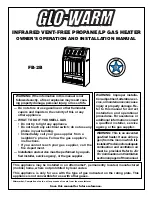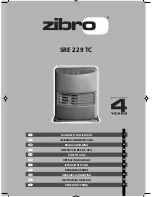
17
All vent gases must be completely vented to the outdoors of the
structure (dwelling). Install only the draft hood provided with the
new water heater and no other draft hood.
Vent pipes must be secured at each joint with sheet metal
screws.
There must be a minimum of 6 inches (153 mm) clearance
between single wall vent pipe and any combustible material.
Fill and seal any clearance between single wall vent pipe and
combustible material with mortar mix, cement, or other
noncombustible substance. For other than single wall, follow
vent pipe manufacturer’s clearance specifications. To insure a
tight fit of the vent pipe in a brick chimney, seal around the vent
pipe with mortar mix cement.
Failure to have required clearances between vent piping and
combustible material will result in a fire hazard.
Be sure vent pipe is properly connected to prevent escape of
dangerous flue gases which could cause deadly asphyxiation.
Chemical vapor corrosion of the flue and vent system may occur
if air for combustion contains certain chemical vapors. Spray
can propellants, cleaning solvents, refrigerator and air
conditioner refrigerants, swimming pool chemicals, calcium and
sodium chloride, waxes, bleach and process chemicals are
typical compounds which are potentially corrosive.
Gas Piping
Make sure the gas supplied is the same type listed on the
model rating plate. The inlet gas pressure must not exceed
14 inch water column (2.6kPa) for natural and propane (L.P.)
gas. If the gas control valve is subjected to pressures exceeding
1/2 pound per square inch (3.5kPa), the damage to the gas
control valve could result in a fire or explosion from leaking
gas.
If the main gas line Shut-off serving all gas appliances is used,
also turn “OFF” the gas at each appliance. Leave all gas
appliances shut “OFF” until the water heater installation is
complete.
A gas line of sufficient size must be run to the water heater.
Consult the current edition of the CAN/CSA - B149.1 Installation
Codes and/or your gas supplier concerning pipe size.
There must be:
•
A readily accessible manual shut off valve in the gas supply
line serving the water heater, and
•
A drip leg (sediment trap) ahead of the gas control valve to
help prevent dirt and foreign materials from entering the gas
control valve.
•
A flexible gas connector or a ground joint union between the
shut off valve and control valve to permit servicing of the unit.
Be sure to check all the gas piping for leaks before lighting the
water heater. Use a soapy water solution, not a match or open
flame. Rinse off soapy solution and wipe dry.
The minimum inlet gas pressure shown on the rating plate is
that which will permit firing at the rated input.
Standard Models
are for installation up to 2,000 feet (610 m)
above sea level.
High Altitude models
are for installation from 2,000 feet
(610 m) to 4,500 feet (1,370 m) above sea level.
If a standard model is installed above 2,000 feet (610 m) or high
altitude model is installed above 4,500 feet (1,370 m), the input
rating should be reduced at the rate of 4 percent for each 1000
feet (305 m) above sea level which requires replacement of the
burner orifice in accordance with CAN/CSA - B149.1.
Contact
Maytag Customer Service Center at 1-800-788-8899 or your
local gas supplier or call for further information.
Summary of Contents for HRX75CQRSCGA
Page 3: ...3 SAFETY PRECAUTIONS ...
Page 19: ...19 OPERATING INSTRUCTIONS ...
Page 29: ......
Page 30: ...30 NOTES ...
Page 31: ...31 NOTES ...
Page 35: ...3 MESURES DE SÉCURITÉ ...
Page 51: ...19 ...
Page 61: ...29 NOTES ...
Page 62: ...30 NOTES ...
Page 63: ...31 NOTES ...
















































